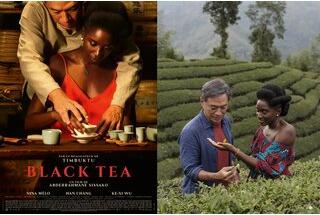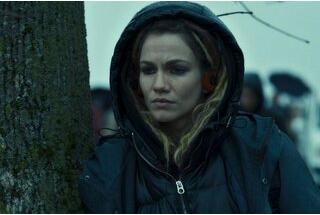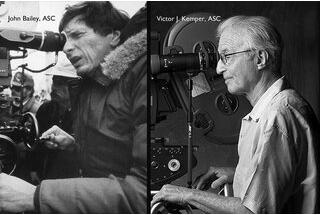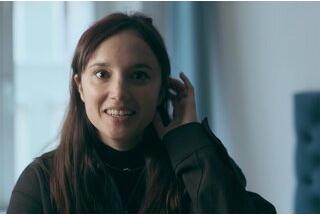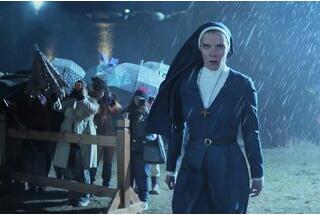Director of photography Charlotte Bruus Christensen speaks about the shooting of "The Banker", by George Nolfi
Heist without gunsTwo African American businessmen, Bernard Garrett and Joe Morris, defy racial laws, in the 1950s in the United States, by recruiting a white worker, Matt Steiner. They decide to install him at the head of their company in order to develop their business.
What was your first contact with the project?
Charlotte Bruus Christensen : I immediately loved the script. It is an important story for me, and one that especially deserved to be told. The basis is authentic, and George Nolfi and the producers made sure to respect the original events as much as possible in the adaptation... although we know cinema often needs more drama or more spectacular things...
The film is retracing the journey of an Afro-American who tries his luck in real estate against racial discrimination of the time. So it seemed important to us to give a visual representation of the places that are almost as important as the characters. Our research in preparation was therefore directed a lot towards the photos of buildings of the time, and an important time was spent choosing each place. The size of certain spaces, for example, have been set on purpose to transpose the social rise of the characters, their gradual takeover. And lensing each setting and each space according to the dramaturgy. Whether for example by losing the characters in a space too large for them, or on the opposite, showing them more in control of things as their real estate business flourishes.

Where did you shoot the film?
CBC : We shot entirely on natural locations, in Atlanta and its surroundings over 43 days, plus 2 days in Los Angeles for some driving shots, or streets exteriors. Georgia therefore provided us with most of the scenery, whether to cheat the Californian part or the Texan part of the plot... It was very motivating for me to take up the challenge of the natural set in the context of an historical recreation. Nothing could be done without the precious help of John Collins, the production designer. Another important detail: George Nolfi wishing a fairly classic image, we went on for a 35mm anamorphic film shoot.
Let’s talk for example about the sequence where Matt Steiner (Nicholas Hoult) is sent in place of the two protagonists to buy a prestigious business building in Los Angeles...
CBC : Oh, so this set was a real challenge for me! We shot this sequence often from low camera positions, with wide lenses to highlight the height of the ceiling. The idea was to set this sort of duel of numbers between the two characters (Matt Steiner - Nicholas Hoult and Charles Renault - Bill Kelly) in a symbolic place of power. I opted for rather harsh sources, a very precise light. We deliberately cut the top beam, just on the forehead of the actors. It immediately gives a slightly retro, almost Hitchcokian look, especially since I chose to shoot this sequence on Kodak 50D film stock, with a light level close to a real outdoor daylight, coming from HMIs. For the record, although we shot maybe six or seven takes, Nicholas Hoult gave us an impressive performance, memorising all the numbers on each take without ever a single miss!


The rendering is quite strange, with almost grey windows despite the feeling of the sun on the actors...
CBC : It was indeed a very gray day, and as we didn’t really have the budget to light all the windows (on the 1st floor) with 18 or 24K, I had to make a choice. Leaving the curtains in a tone where you can quite read the material is something I like to do anyway. And then it pulls up that 50’s studio look ... As a director of photography, you really have to adapt yourself to each place, to its constraints, and end up with something that serves the film.

What lenses did you shoot with?
CBC : The whole start of filming was done with anamorphic lenses, but a technical problem with one of them (a front lens that had come loose) led us to shoot some retakes. Because we did not want to take any risk on the rest of the shooting (the budget of the film being just fair for a period movie), we chose to shoot then on spherical lenses. Some tweaks were therefore necessary in color timing for shots to match… In summary, almost all the exteriors were shot in anamorphic, while the interiors, like this sequence of dueling numbers, were shot spherical.
What about golf training?
CBC : This funny golf sequence was shot in Scope. It was also a bit of a difficult scene for me. The green was so present, I was happy to shoot in film because I find that the natural rendering of this color always looks better in film than in digital. The Panavision-C series helped me also quite a bit, with its natural smoothness, and warmth that makes things easier in post. From a narrative standpoint, this moment is in the tone of pure comedy. Two people trying to teach a third one how to become a good golf player… When he does not even hit a ball... Given this eccentric context, this is also a montage sequence, and I thought we had to stay very sober in the image. The film suddenly takes a little humorous break but without showing the effect on the camera. The camera challenge was like any outdoor scene: shooting continuously over several days, and manage the changes in natural light with the first AD’s help. While maintaining rather low contrasts, without real highlights nor deep blacks... a rounded and comfortable image in a way…

Glasses are handy for giving shine to the faces of the two businessmen, right?
CBC : Yes, glasses can often be a real pain, but they also sometimes have their good sides! And then it instantly helped for the 50’s style. Anyway the costumes were perfect on this scene. Samuel Jackson’s golf outfit is amazing!
What about the night talk between Joe and Bernard on the terrace?
CBC : An important sequence; this is when Bernard’s wins Joe’s trust ... The script was mentioning the two characters isolating themselves for this dialogue. Bringing them out seemed perfectly suitable to us, the atmosphere of the jazz club remaining in the background via the door opening onto this terrace... The moonlight seemed irrelevant to us because it was too romantic. It is rather the half-light of the city that seems to light them up, keeping on Samuel Jackson’s (Joe’s) axis some kind of backlight coming from the exit of the dance hall. It allowed us to highlight the smoke of his cigar, giving a sort of halo, and presence, strength on the screen. Anthony Mackie (Bernard) is more glued to the wall, without backlight, in a less favorable position. The scene also turns to the profit of Samuel Jackson, who literally reads his future partner’s mind, and gently teases him at the end of the sequence. Here too, the low angle and the slightly short focal lengths give a lot of presence to the character of Joe Morris.

A review?
CBC : I am proud of the way in which we were able to film these natural sets by integrating them both into the dramaturgy, while respecting the 50’s period. And with a limited budget ($ 12M). We managed to bring to the screen not only people who discuss in interiors, but indeed a complete world with these buildings, sometimes its streets, its atmosphere ... A resolutely open film where the space is on the screen.
(Interview conducted by François Reumont, for the AFC)
The Banker
Directed by George Nolfi
Cinematographer: Charlotte Bruus Christensen
Production Design: John Collins
Costumes: Aiesha Li
Editing: Joel Viertel.
 En
En
 Fr
Fr
